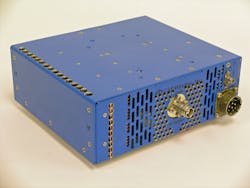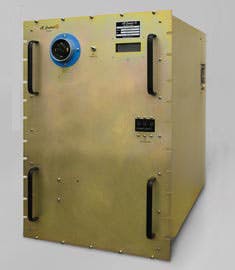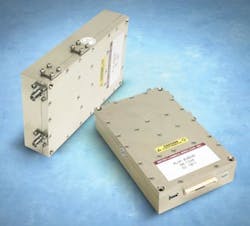Every year, the Association of Old Crows (AOC) gathers in a different city. This professional organization is comprised of past, present, and future soldiers, along with the electronics manufacturers hoping to supply their battlefield needs. This year, the 49th Annual International AOC Symposium & Convention took place Sept. 23-26 at the Phoenix Convention Center (Phoenix, AZ) sporting the theme of “Arming the Spectrum Warrior.”
The event featured several excellent keynote addresses. These included a talk on the evolution of the National Security Agency (NSA) by Dr. Eric Haseltine, the agency’s former Director of Research. Also featured was a discussion on the future needs for small-signal detection on the battlefield presented by Jeff Jones, Fellow and Chief Scientist of the IBM Analytics Group. In addition, the exhibition floor was filled with a large number of company representatives and their visitors, all hoping to learn more about the continuing role of RF/microwave components, materials, subsystems, software, and test equipment for the next generation of electronic battlefield systems.
In terms of emerging RF/microwave technology, the relatively small exhibition floor was bustling with points of interest, including the show of Spatium™ power amplifier technology from CAP Wireless. These are reliable solid-state amplifiers based on gallium arsenide (GaAs) or gallium nitride (GaN) device technologies, using quasi-optical combining to sum the outputs of individual solid-state devices or amplifiers in free space, rather than through a stripline or microstrip power combiner with much greater loss (and loss of output power). By combining the contributions of individual monolithic-microwave-integrated-circuit (MMIC) amplifiers, the company has developed Spatium power amplifiers operating through 40 GHz.
The Spatium technology appeals to various branches of the US military for its capability of delivering high output-power levels in much smaller and lighter packages than the technology it replaces, traveling-wave-tube amplifiers (TWTAs). Another positive aspect of the Spatium amplifiers is that, unlike a TWTA—in which the amplifier can be shut down with the failure of a single vacuum-tube device—the Spatium amplifiers undergo what is known as a “soft” failure mode. Even if one or more of the solid-state amplifiers in a Spatium enclosure fail, the amplifier will continue operating, albeit with reduced gain and output power.
CAP Wireless brought several examples of this technology to the AOC exhibition, notably an X-band amplifier developed for electronic-warfare (EW) applications (Fig. 1). Available as a single-channel design with 100 W output power, or a dual-channel amplifier with 50 W output power per channel, the X-band amplifier is a direct bolt-in replacement for TWTAs in EW systems (although with superior noise and harmonic distortion characteristics to the vacuum-tube amplifiers). From 8 to 11 GHz, a model XS259900 dual-channel X-band amplifier provides better than 30% drain efficiency.
For a look at the alternative technology, visitors to the dB Control booth could size up the dB-3902 power-combined TWTA (Fig. 2) with as much as 8 kW peak output power at 6% duty cycle from 4 to 8 GHz. It employs two periodic-permanent-magnet (PPM)-focused traveling-wave tubes (TWTs) to achieve its rates output power. The firm minimizes losses through the power combiners, carefully matching the amplitude and phase characteristics of the two TWTs for optimum amplifier performance. The C-band model dB-3902 provides 60-dB minimum gain from 4 to 8 GHz with better than -10 dBc harmonics and -50 dBc spurious levels. It includes numerous protection functions, including against TWT over-temperature and TWT helix over-current conditions. The TWTA measures 18 x 28 x 36 in. and weighs 300 lbs.
2. Model dB-3902 is a power-combined TWTA with as much as 8 kW peak output power from 4 to 8 GHz.[Photo courtesy of dB Control (www.dbcontrol.com).]
Communications & Power Industries was also on hand at the 49th AOC with an example of its high-power vacuum-tube capability in tow: the model VTX-5682A pulsed coupled-cavity TWT, with 30 kW peak output power (at 1% pulsed duty cycle) from 9.0 to 9.5 GHz. It is designed for use with 0.25-W input power and 50-{LC MU}s pulse widths. The tube provides 48-dB gain, and is equipped with WR-90 waveguide input and output ports to handle the high power levels. The TWT measures 4 x 4 x 18 in. and weighs 16 lbs.
Micro Lambda Wireless showed several examples of its YIG-based technology, including its lines of tunable filters and oscillators. The firm also displayed the capabilities of its frequency synthesizers, including the MLSP Series sources for frequency bands of 2 to 18 GHz and 2 to 20 GHz (Fig. 3). These YIG-based synthesizers include models MLSP-2018 (with a frequency range from 2 to 18 GHz) and MLSP02020 (which runs from 2 to 20 GHz). The synthesizers tune with 1-kHz resolution and can switch frequencies as fast as 1 ms. Typical spurious levels are -60 dBc; phase noise is typically -93 dBc/Hz offset 10 kHz from the carrier and -114 dBc/Hz offset 100 kHz from the carrier. Both synthesizers are rated for +10 dBm output power across the frequency ranges and can be specified for operating temperature ranges as wide as -20 to +70°C.
3. The MLSP Series of frequency synthesizers provide +10 dBm output power across frequency ranges of 2 to 18 GHz and 2 to 20 GHz [Photo courtesy of Micro Lambda Wireless (www.microlambdawireless.com).]
FEI-Elcom Tech also showed its frequency synthesizers at the AOC exhibition hall, although with slightly faster switching speeds. The firm’s UFS line of ultrawideband frequency synthesizers includes models covering 0.3 to 3.0 GHz (model UFS-3), 0.3 to 4.0 GHz (model UFS-4), and 0.3 to 18.0 GHz (model UFS-18) with +10-dBm typical output power across their frequency ranges. These synthesizers shift frequencies in about 250 ns for a full-band switch, and tune with 1-Hz frequency resolution. Harmonic levels are only -50 dBc while spurious levels are -65 dBc. The frequency synthesizers boast a low phase-noise floor of -147 dBc/Hz through 18 GHz and phase noise of only -135 dBc/Hz offset 1 MHz from a 10-GHz carrier. The sources are ideal for applications in EW systems, in signal-intelligence (SIGINT) systems, automatic-test-equipment (ATE) systems, and for frequency-agile radar systems.
At the system level, ITT Exelis announced its Exelis GPS Interference, Detection, and Geolocation (IDG) system for near real-time geolocation of intentional and unintentional GPS jamming sources; it operates through a network of sensors and advanced geolocation technology. IDG technology is based upon a network of threat-detection sensors networked to a centralized server running Exelis geolocation algorithms. The sensors might be placed around an airport or other high-risk area, for example. The IDG system can detect, analyze, and geolocate any hostile signal sources and send the captured intelligence through a secure network to analyze the scenario and mitigate the threat.
During the AOC event, BAE Systems announced several items of good news. The firm’s Australian arm had been awarded a contract from the New Air Combat Capability (NACC) Program to develop an operational model to integrate the Joint Strike Fighter (JSF) into the Australian Defense Environment. Also, the company had been selected by major defense contractor Raytheon Co. to help develop the US Air Force’s Dismount Detection Radar (DDR). The company will lead the development of the DDR’s radar command, control, processing, exploitation, dissemination, and mission-planning modules. Raytheon was awarded the contract for the DDR system in July, tasked with producing four radar pods with ground moving-target-indication (MTI) and synthetic aperture radar (SAR) technology. The radar will be mounted under the wings of MQ-9 Reaper aircraft. The radar is intended to provide information for Air Force intelligence, surveillance, and reconnaissance (ISR) missions. Raytheon will develop the ground stations for the system.
Also during the AOC exhibition, Mercury Computer Systems announced its Echotek® Series SCFE-V6-4QSFP-OVPX OpenVPX™ fiber-optic input/output (I/O) module, which has the capability to transfer and process data across 16 channels in a single OpenVPX slot. Ideal for EW applications, the module combines 16 high-speed channels with three powerful Virtex®-6 field-programmable gate arrays (FPGAs) from Xilinx. The module features maximum data-transfer capacity of 80 Gb/s and is well suited for processing the large amounts of data from ISR sensors.
On the AOC exhibition floor, X-COM Systems, LLC, a subsidiary of Bird Technologies, demonstrated Version 3.0 of its RF Editor Graphical RF Editor software. The program supports the creation and modification of custom RF signal waveform files for use in defense, commercial, and system verification applications. It is suitable for modifying captured radar, jammer, and communications signals to create simulated threat scenarios, as well as to verify the performance of communications, electronic warfare, and radar systems. The software runs on a Windows 7 personal computer (PC) and can work with files from spectrum and signal analyzer, in addition to waveform segments created in MATLAB and other third-party scientific programming languages.
About the Author
Jack Browne
Technical Contributor
Jack Browne, Technical Contributor, has worked in technical publishing for over 30 years. He managed the content and production of three technical journals while at the American Institute of Physics, including Medical Physics and the Journal of Vacuum Science & Technology. He has been a Publisher and Editor for Penton Media, started the firm’s Wireless Symposium & Exhibition trade show in 1993, and currently serves as Technical Contributor for that company's Microwaves & RF magazine. Browne, who holds a BS in Mathematics from City College of New York and BA degrees in English and Philosophy from Fordham University, is a member of the IEEE.


